#commentary and analysis
Text
Rings of Power ‘Review,’ featuring wood-elves and gender
I’m writing this for two reasons. Firstly, processing things in writing sometimes lets me stop obsessively thinking about them and actually get on with my life, which has been a major issue for me this past week. Second, people keep asking me what I think of the show and who I think The Stranger is (which I won’t actually be talking about here, but short answer is one of the Istari, probably Gandalf, which doesn’t make canonical/historical sense but does make narrative sense, though the Blue Wizards make historical/timeline sense, based on drafts/notes – phew!). Anyway, it is exhausting and anxiety-provoking to give the same thoughts to people across different parts of my life repeatedly, so I am putting it all in one place, though I would not count on this every week. So. Transitioning to the essay, which will be heavily footnoted, just like the Professor himself. I am not sorry.
Thoughts on Rings of Power: Episodes 1 and 2
Rings of Power (RoP) has proved to be a different story than most of us could have guessed, given the scant scaffolding provided on the First and Second Ages in the The Hobbit (TH), The Lord of the Rings (LotR), and the LotR Appendices, those sources show-creators actually have access to directly use. (Admittedly, info on the Second Age anywhere is sparse, per not only Tolkien’s own admission in Letters but fans’ own scouring of the texts and drafts for scraps of lore.) In this post, I want to talk about some of the things I loved and did not love about the first two episodes of this particular adaptation. I will try not to get super into the weeds with lore here, because most people who follow me in these spaces already understand how this adaptation changed major plot, character history, and historical points. Instead, I want to talk about (a) my personal experiences with RoP, including (i) pre-watching anxieties and beliefs and (ii) watching- and fandom-related joys; and (b) my ongoing and developing thoughts about (i) Silvan and Nandorin representation in the context of intra-elven relations in the larger legendarium and (ii) concepts of gender reflected in RoP design choices.
Personal Experience
First, I want to talk about how I prepared for this adaptation, which is that I acknowledged it, ignored it, and then went feral with excitement (and debilitating anxiety) about it, all within the course of a one-year period. Anyone who knows me in fandom probably knows that–when I have enough energy to consistently engage–I try very hard to make the Tolkien world a welcoming place for people. As someone who was a child/teen in online Tolkien fandom as Peter Jackson’s adaptations were coming out (yes, I discovered fanfiction perhaps way too early), I was quite traumatized by some older, lore-heavy fans who vehemently corrected–and sometimes even subtly mocked–me as I was working my way through the appendices, the Silmarillion, and Unfinished Tales. I am therefore very passionate about civility (within reason–I draw the line at supremacist nonsense) in fandom spaces. Ultimately, I never want rejection or belittling–subtle or outright–to be how people experience Tolkien fandom, or even scholarship: gatekeeping helps no one. (Insert boost for the new blog @tolkienfandomagainstgatekeeping!).
Still, while I did preach kindness and encouraged welcoming behavior in the year preceding the release, I nevertheless experienced a lot of change-related anxiety as a neurodivergent person preparing for the potential fandom-related change bound to happen in online Tolkien communities as we processed the new show; dealt with some people’s real (and, admittedly, sometimes scary) rage regarding–and therefore their disingenuous attempts to derail the success of the show due to–race and white supremacy; and, finally, prepared for the influx of fans to the open system of online fandom. I had to take a break from actively engaging with fandom because I could not handle the constant RoP-related emotional stimulus from all sides. However, when I saw the final RoP trailer, their sweeping vision of Middle-earth blew me away–my anxiety morphed into excitement by the end of those three minutes. I did not sleep the night before it came out, and I had to take off work the days after to emotionally recover from it.[1] (I unfortunately do not make the rules for how, when, and why my brain is overstimulated.)
Appreciated Moments
At this point, I will transition to a few things that I absolutely loved. This section is less critical and lore-heavy than the following ones, but we will start with a pseudo-lore moment I loved: the symbolism of the opening scene with Galadriel and the other children. While the show cannot talk about the Kinslayings–which is hugely problematic to me from an elven relations and politics perspective (more on that later)–this scene is very clearly an allusion to the Kinslaying at Alqualondë and the burning of the Telerin swan boats.[2] Whether these children who are harassing Galadriel are actually her Feanorian cousins or not, we cannot guess for certain, as we don’t have a clear birthdate for most of the younger Finweans.[3] (Further, if we think about it too hard, things get complicated and confusing very quickly.)[4] Still, it was a nice little homage to the parts of history the show is not allowed to talk about–I teared up due to the beauty of the setting combined with the lore it evoked, which is a very near and dear part of the legendarium to me. That being said, I think that opening scene made some of the lore choices that followed hurt all the more for those of us who did immediately understand the reference, as it alluded to an imminent complexity and nuance that, for me, the show ultimately did not–and, frankly, cannot–deliver. Still, I liked it. Mostly.
Next, I appreciated moments of the dwarven representation, and every single moment of the dwarven design. Having been introduced to LotR prior to Peter Jackson’s (PJ’s) adaptation, I latched onto a few characters at a young age and, for me–for some reason–that was Legolas and Gimli. Gimli in the books is rational yet passionate but, more than anything, he is silvertongued and poetic. As much as I love John Rhys-Davies’ performance in the PJ films, the writers made some mistakes in their choices regarding his role as, almost entirely, comic relief. The representation in the dwarves of Khazad-dum/Moria in this adaptation goes some way in repairing the lasting image of dwarves that took hold in fan communities following the PJ films. I found the opening scene–in which the dwarves challenged Elrond to a…show of strength?–a little hard to follow and a bit strange and othering given the show is told almost entirely from an elven point of view thus far, but I was overall pleased. I found Durin III and Disa likable, and the scene at the kitchen table went a long way to endearing Elrond’s character in this adaptation to me, while cementing Disa as an excellent original character in her own right. Overall, the design team blew me away with their conception of Khazad-dum. The ferns hanging off the side of the cliff inside the entrance illogically moved me to tears, and the dwarven ingenuity represented by the pulley-based elevator system felt very true to how I have always imagined dwarves. My only hope is that Celebrimbor and Narvi have some screentime. Elrond can't have everything.
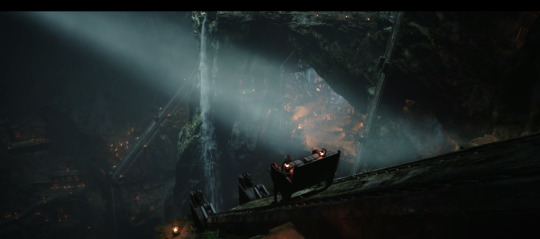
Finally, like almost everyone, I enjoyed the Harfoots. [5] While I have heard a lot of commentary about how “hobbits weren’t supposed to be involved in the major events of the Second Age!!”, I also think it’s worth reminding the world that (a) hobbit-like folk were living in the Vales of Anduin by the Third Age, and it would be absolutely bonkers to think they never interacted with or minorly influenced characters who do have a “documented” role if they had been out and about earlier; (b) almost everything Tolkien wrote about history is written “within” his Secondary World, i.e., by one of the characters he imagined kept historical records and, thus, there is likely inherent narrative bias to what we do “know” about the Second Age; and (c) wood-elves were mostly only mentioned in the context of the Second Age in relation to Sindarin and Noldorin migration and expansion, but no one is complaining about Arondir. (Okay, they are, but they’re complaining about him for racist reasons, not simply because wood-elves exist in this telling.)
Oh, and the music! I am not the right person to talk about the music, but that–combined with the gorgeous design and setting–will keep me coming back for the rest of the season, regardless of what happens.
Nandorin-Silvan Elves, Intra-elven Relations, and the Related Significance of Omitted Elven History
Now, on to the critique. Let me start by saying: this section is heavily influenced by the utter bewilderment I have felt over the past year trying to understand how a show can be set in the Second Age without rights to most of the material of the First. What is the point in making a show when you cannot actually adapt the material realistically? While that is not the point of this section, it is hard for me to disentangle, so it feels only right to mention it.
Since I started writing this review, I came across @itariilles own excellent review on elves in the first two episodes of RoP. I recommend reading her piece as I will not be rehashing the points she made here regarding Galadriel’s character and motivation(s) or the complexity of casting an actor of color as a Silvan elf, with particular attention to her sections “Galadriel’s Motivations” and “Fantasy Racism Against Elves.” To understand more where some of the frustrations expressed by Itariiles, myself, and many other fans come from, I would further, and selfishly perhaps, recommend reading the section Consequences of Resettlement: The “Sindarizing” of the “Wild,” “Lesser” Elves by the Sindarin Princes and Noldorin Exiles of Beleriand in my linked paper here. Because I cannot write this section without at least mentioning elven ethnicity and lore, I do suggest refreshing your brain if you are not familiar with elven cultural groups across the Ages; and then proceed while keeping in mind the following: “Within Tolkien’s elven worlds, these [elven] hierarchies are governed by (a) proximity to Aman and the Valar and, within Middle-earth, (b) proximity to the Noldor, with the Nandor and then the Avari being most distant. Characteristic phrases used to describe the Silvan and Avari are ‘lesser Elves,’ ‘lesser Silvan race,’ ‘wild,’ ‘savage,’ ‘rude and rustic,’ and ‘more dangerous, less wise’” (...me, 2021). [6]
Itariiiles’ does an excellent job outlining why it is odd Silvan elves would be reporting to the High King Gil-galad at this point in Second Age history. She additionally reviews the complexity of the showrunners placing the Tirharad (the human people we see in the Southlands parts of the episode) under Elven dominion. She notes, “A line said by a Silvan soldier reasoning their station over the men of Tirharad as ‘descendants of those who served Morgoth' is uncomfortable as it plays into the established trope of South/Eastern men being inherently evil which links into Orientalist ideas of the East being perceived as fundamentally Other.” This is something I want to take a step further. In this adapted world in which, presumably, Silvan elves answer to the “higher” Noldor, what does it mean that the Silvan folk are being used to carry out what essentially amounts to Noldorin occupation of Mannish lands?
I have a few issues with this, and it has taken me a while to really pinpoint why, and I’m still not quite there on expressing it and do not expect to be until I have more data from the show. Still, the first thing that bothers me about this setup is that–in this adapted universe–the Silvans reporting to the High Noldor creates unique issues across multiple contexts:
If we are fans of the traditional legendarium, this choice in the adaptation puts the Silvan in an even more more subservient context that Tolkien’s explicit and implicit language originally placed them (which is highly impressive); and
It tells us that within the adapted universe, the Noldor use another ethnic group–one traditionally ranked less highly–to carry out suppression and oversight of a third ethnic group.
This approach has not been uncommon in colonial and neocolonial history and, certainly, utilizing another group of people to establish and maintain strategic governmental and military control is part and parcel of imperialism. While all elves–in the ethnic hierarchy of Middle-earth–may be ranked higher than Men (due to being valued as firstborn by Illuvatar) and, thus, this oppression is not exactly lateral, it is still using one group of people to manage another, while the person in charge essentially handles war, decisions, and paperwork elsewhere.
Of course, all of this whining and speculating could be blown out of the water by something I could never have expected in this RoP universe as the episodes progress–in that they go “on record” changing the history of these ethnic and racial groups, or they reveal that the Noldor are already integrated with the Silvan at this point–but my hopes are not high. Itariiiles’ point–one also made by a speaker on the RoP reaction panel at Oxonmoot, as well (@fernstrike)–still is not insignificant: What does it mean that the only actor of color cast as an elf thus far is a Silvan reporting to the Noldor, while all the Noldor we have seen–in the first two episodes, at least–are white? We cannot escape the potential impact, as choices in the Secondary World/in-universe are inherently consumed by those of us in this Primary World we share.
My next issue with the flattening of elven history and culture centers on the Sindar, part of the Teleri group to which the Silvan also belong. As @skyeventide asked in her reaction thread (featuring my highly articulate response):

So then: where are the Sindar at this time? And the “Sindarin Princes of the Silvan Elves”? Given the fact that Durin III is alive and Eregion and Celebrimbor aren’t wasted or strung up, respectively, we can guess a timeframe of a few hundred years for the show, during which the Sindar are certainly out and about, depending on the draft/source (Celeborn in Lindon, Oropher & co. already settling with the Silvan across the mountains). And it is not as if the Sindar are forbidden by copyright to be discussed: Though Doriath is destroyed by the Second Age, it and Thingol are still discussed in the LotR appendices; there is a paragraph exclusively dedicated to how the Sindar migrated and integrated with Silvans in the woods during the time Gil-galad is High King [7]; and Nimrodel’s story and associated Sindarin and Noldorin woes are mentioned in LotR. Certainly it is not unreasonable that this is a storyline that will emerge throughout the season (or the next four, which could ostensibly cover thousands of years), but considering the placement of Silvans beneath Gil-galad at this time, I am wary. Should Thranduil emerge (as Oropher is not mentioned in LotR or the Appendices)–or Amroth or Celeborn (who all also have messy histories across various versions and drafts)–what shall happen? Will the Sindar be placed under the High King’s jurisdiction? Will the Silvans who are not already, apparently, ruled by Gil-galad be lumped in with them, under the High elves, as well?[8]
I can only hope there will be some thoughtful delineation of groups and meaningful and realistic group dynamics based on Elven history and–gasp–even informed by modern political science, social psychology, sociology, or migration studies. Even if the “why” is not immediately apparent in the show, interested viewers can easily look up the backstory and, thus, the show avoids unintentionally rewriting cultural histories (which, real history or not, is tiresome), a constant risk in stories with colonial and neocolonial settings/actors. Ultimately, my biggest concern as a person who thinks way too much about Elven ethnic hierarchy and social stratification is that instead of using the actual history of elven migration, conflict, and the long-lasting effects of the Kinslayings to explain the creation of differing elven realms, the very same effect will be attempted in another manner, i.e., by pinning a split from the Noldor as a personal flaw or choice of some yet unknown Telerin leader, or by having Silvans rebel against Gil-galad’s leadership and thereafter align themselves with certain Noldorin-type leaders (e.g., Galadriel and Celeborn) or Sindarin leaders with skeptical attitudes toward all things High Elven (e.g., Oropher Thranduil).[9] I can see these approaches making narrative sense based on some things that have already been set up in the first two episodes. However, I am still giving myself permission to be skeptical about it and to also just… not particularly like it.
Now, of course, all of this relates to that omitted Elven history, one genre of omission more glaring than all the rest: the flight of the Noldor, the Oath of Fëanor, and the three Kinslayings that followed. The inability of showrunners to incorporate, or even really reference, these events surrounding the Silmarils is disappointing. War is complicated and, to most sides, generally unjust for one reason or another, which is certainly something viewers can relate to. Furthermore, flawed characters are interesting, even if they are flawed because they participated in or failed to actively oppose actions most would now consider unthinkable. Still, the political intrigue and narrative arcs that facilitate this kind of in-universe justification of atrocity in fictional worlds has long been a compelling storyline in myth, religion, and fiction alike. Even Galadriel’s character could be complicated by acknowledging this complex history, or–given copyright limitations–at least creating some alternative scenario that evokes the same historical complexity that the entirety of the First Age embodies, pitting elf against elf against man against elf, all of which barely pales in comparison to The War of Wrath. Galadriel’s behavior in “The Noldor in Beleriand” chapter of the Silmarillion during her conversation with Melian of Doriath (about why the Noldor returned from Aman) lays the groundwork for the type of high political drama this show could evoke, regardless of copyright.[10]
Ultimately, while Tolkien is well-loved by many due to his skill–intentional or not–in creating morally ambiguous characters, perhaps the showrunners are not prepared to address such complexity on screen. As those of us in the Silmarillion fandom know, discussing the human–elf?–rights violations at Alqualondë, Doriath, and Sirion can be tetchy [11], and inviting such tension to a show in the midst of the political uproar surrounding its very existence may have been too much to expect. However, because so much of elven history and hierarchy is situated within splits and migrations directly associated with the story of the Silmarils, it does feel that we are being cheated–especially fans of the Telerin Sindar and Silvan–of the complex story the elves deserve.
This Section Was Supposed to Be: Gender in the Primary and Secondary Worlds of the Original Legendarium and the RoP Adaptation
In this section, I meant to define Primary and Secondary Worlds according to Tolkien’s definitions in “On Fairy Stories,” weave a pretty little tale, and then right-left-punch you with the historical, modern, and in-universe implications of the weird decisions the show made about women.[12] While there is a lot to be said about the racial and ethnic implications of costuming decisions, this post was going to specifically focus on gender, clothing, and gender-related roles in those first two episodes.[13] I was also going to discuss gender-related costuming and cultural-cult-religious implications in some of the other imagery here. (Rest assured, I am certain I am not the first person who did a double-take at that boat scene.) However…. I am tired, I have a project for my research supervisor due tomorrow, and I am not going to let something I love (Tolkien) give me a mental breakdown once again, so I am abandoning that original plan. Instead of a well-crafted section, allow me to ramble at you about gender and, canonically, why I think the elven women in Lindon are ridiculously designed.
Now.
Tolkien and his legendarium were never the height of gender equality and progressivism, but they were also not exactly the worst, if we ignore the fact that he didn’t particularly care for short-haired women wearing pants (Letters) and also that he thought–at least at one point–that elven woman would be pregnant (and thus secluded from larger society??) for 100 years (Nature of Middle-earth, 2021). (Yeah, that’s absolutely bonkers, I know.) However, the text most fans have relied on for years–and which is not directly contradicted in NoME–is “Laws and Customs of the Eldar,” or LaCE in fan parlance.[14] LaCE fairly explicitly describes the similarities and differences between elven men (neri in Quenya) and women (nissi in Quenya), as reported by an unknown Mannish loremaster. Tolkien (said loremaster) writes:
In all such things, not concerned with the bringing forth of children, the neri and nissi (that is, the men and women) of the Eldar are equal - unless it be in this (as they themselves say) that for the nissi the making of things new is for the most part shown in the forming of their children, so that invention and change is otherwise mostly brought about by the neri. There are, however, no matters which among the Eldar only a ner can think or do, or others with which only a nis is concerned. There are indeed some differences between the natural inclinations of neri and nissi, and other differences that have been established by custom (varying in place and in time, and in the several races of the Eldar). For instance, the arts of healing, and all that touches on the care of the body, are among all the Eldar most practised by the nissi; whereas it was the elven-men who bore arms at need. And the Eldar deemed that the dealing of death, even when lawful or under necessity, diminished the power of healing, and that the virtue of the nissi in this matter was due rather to their abstaining from hunting or war than to any special power that went with their womanhood. Indeed in dire straits or desperate defence, the nissi fought valiantly, and there was less difference in strength and speed between elven-men and elven-women that had not borne child than is seen among mortals. On the other hand many elven-men were great healers and skilled in the lore of living bodies, though such men abstained from hunting, and went not to war until the last need.
As for other matters, we may speak of the customs of the Noldor (of whom most is known in Middle-earth). Among the Noldor it may be seen that the making of bread is done mostly by women; and the making of the lembas is by ancient law reserved to them. Yet the cooking and preparing of other food is generally a task and pleasure of men. The nissi are more often skilled in the tending of fields and gardens, in playing upon instruments of music, and in the spinning, weaving, fashioning, and adornment of all threads and cloths; and in matters of lore they love most the histories of the Eldar and of the houses of the Noldor; and all matters of kinship and descent are held by them in memory. But the neri are more skilled as smiths and wrights, as carvers of wood and stone, and as jewellers. It is they for the most part who compose musics and make the instruments, or devise new ones; they are the chief poets and students of languages and inventors of words. Many of them delight in forestry and in the lore of the wild, seeking the friendship of all things that grow or live there in freedom. But all these things, and other matters of labour and play, or of deeper knowledge concerning being and the life of the World, may at different times be pursued by any among the Noldor, be they neri or nissi.
(Morgoth’s Ring, HoME 10).
So then, why does elven gender in RoP weird me out a little bit, Galadriel–and her complicated characterization–notwithstanding? (And, yes, it was necessary to include the full quote to only point out how much more ridiculous what follows is.)
This:
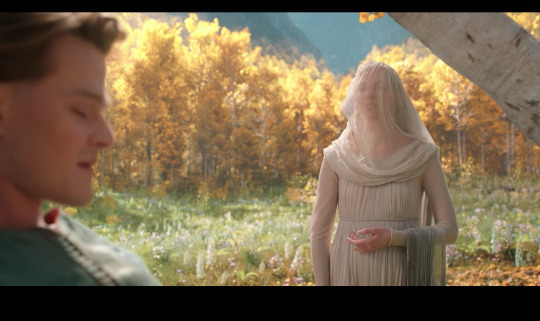


Why are all the attendants female? And why are they all dressed like this in the background? Where are the rest of the women? Are they locked away, pregnant? Did we take NoME that seriously?
Bizarre.
Conclusion
In the big scheme of things, I suppose I was mostly pleasantly surprised. It was entertaining to watch for the scenery, settings, and music; and I was moved to tears by some of the beautiful cinematography–I’ll continue to be giddy about the scenery and design whether I want to be or not. I also think it is very important that BIPOC were included in casting. However, I am not going to hold out on feeling the story of the Second Age was done justice. I will–forever and always–always be hung up on Silvan representation.[15] But, unless something truly egregious happens, for now I am okay with a mediocre and mildly frustrating storyline.
FOOTNOTES
I have still not recovered, so this will be a long 1.5 months.
Not to mention the boats she will one day have in her own realm, in Lothlorien.
As Sky Eventide notes in her reaction thread on Twitter, the scene even includes one red-headed child, which may be harkening to Maedhros, though Amrod or Amras might be more realistic given I would expect Maedhros to be the ringleader of the band, were the red-headed child meant to be him.
See Itariilles’ piece and my own linked paper for more on this. It is confusing to think about in the show context because while Galadriel thinks the kinslaying are unfortunate and does not take an oath like Feanor and colleagues, she doesn’t think her Feanorian cousins are crazy for wanting to return to Middle-earth, though her motivations to return are different (yay colonialism). Again, see links.
Though an Irish Times article provides an interesting critique that, as an American many generations removed from Ireland, I would never have noticed. As someone who often complains about fandom’s jokes about wood-elf and Silvan culture/language as a stand-in for less cultured “hick” accents and cultures, the linked article really moved me and put these European-based English choices into perspective for me. And it also spoke to the odd feeling I got as I noticed that while watching, once again, an adaptation used different accents that are cultural- and class-marked in the ‘real world’ to sort of delineate place in Middle-earth.
And yes, some of this quoted language comes from material the show has explicit access to.
Keep in mind, this is only ONE version of Sindarin migration. Tolkien wrote more on this across his lifetime that is not reflected in the Appendices as published. See my linked paper for more on this.
Dare I even ask if the show plans to somehow reference a group of elves like the Avari, given the showrunners’ interest in the Southlands thus far? I don’t know if my poor heart could handle the stress…
Which conveniently echoes Oropher’s choice during part of the Last Alliance that left his people wildly diminished…
A political intrigue which we have seen snippets of, perhaps, with Elrond’s character–it’s just not a tension and positioning I can, yet, easily follow. I don’t ‘get’ this world well enough yet to do so.
I, too, have been guilty of this, as someone who spends way too much time thinking about the Sindar. While I am still very much opposed to atrocity crimes in our real world–obviously, it’s literally my job–I have come to see the issues of the Silmarils as more complex than I once did, taking into account cultural and political motivations for character behavior. (Though that has not stopped me from writing Sindarin accounts of the Kinslaying at Sirion to balance things out, “victors write history” and all that.) I have some patient acquaintances to thank for helping me develop a more complex view on Feanorian behavior in the First Age.
Do not judge me. I know nothing about boxing terms and I made that up.
Again, please read Itariiles’ piece (specifically the section “Neoclassical Aesthetic Given to the Noldor and its Unfortunate Implications”).
And, if you want to get really particular, one of the two drafts of LaCE is titled: “OF THE LAWS AND CUSTOMS AMONG THE ELDAR PERTAINING TO MARRIAGE AND OTHER MATTERS RELATED THERETO: TOGETHER WITH THE STATUTE OF FINWE AND MIRIEL AND THE DEBATE OF THE VALAR AT ITS MAKING”...
And yes. I have lived through PJ’s TH. I will survive it again.
Acknowledgements: Thanks to my acquaintances from the Silmarillion Writers’ Guild/Dreamwidth for encouraging me to finish writing this after I became discouraged. And thanks to my new acquaintances at Alliance of Arda for being interested in what I have to say. I would have just stewed in my anxiety without outside prompting to write this silly little thing that I actually really wanted to write.
92 notes
·
View notes
Text
Jason is an "I'd kill for you" person stuck in a "live for me" family.
#dc#comics#dc comics#comic books#jason todd#red hood#jason peter todd#the red hood#batfamily#batfam#batkids#batsiblings#found family#media analysis#media commentary#character analysis#character dynamics#funny
13K notes
·
View notes
Text
ty lee is by far the most underrated atla character imo. as far as minor principal players, it’s easy to disregard her as the least fleshed out fire nation kid, the most underdeveloped. her role as a foil to any of the main characters is vague, and many people just assume she’s there to bring some sort of levity and humor to azula’s plotline. she’s dismissed as the pretty ditzy girl, or even (shudders) “the bimbo.” but when you actually make the effort to consider what we do see of her, to extrapolate from her few yet crucial scenes anything regarding her underlying motivations, you quickly realize that one of the most layered, multifaceted, compelling, intriguing, ambiguous, and perhaps even straight up insane characters in the entire show has been hiding in plain sight all along. and also that that’s the entire point.
#SHE DIDNT JUST FOOL AZULA (& al) SHE ALSO FOOLED US! THE AUDIENCE!!!#or well. most of you. not me tho im different#ty lee#I love you commentary on femininity and power dynamics girl#it feels like only mailee and tyzula shippers actually give a shit abt her#(tysuki shippers too i guess)#but even individually she is just. SO fascinating!!!!#masks & performance & acrobatics & taking you down from the inside!!!!!#I need to write an actual longass character analysis of her someday#I know I already kind of did but it was pretty shallow iirc#I think I can go deeper.
1K notes
·
View notes
Text
Gortash designs and builds mechanisms so I imagine he has to be able to sketch fairly decently in order to sketch his projects and designs. And I'm imagining a pile of charcoal sketches of Durge, done over their entire acquaintance, starting out with sketches of them in battle and then slowly becoming more detailed and intimate and as they do, the titles changing from things like "The Bhaalspawn" and "Bhaal's Chosen at Their Bloody Work" to "The Chosen in Contemplation" and finally just Durge's name
#it's speculated that the individual pictured in these sketches is [name] who was thought to have resolved the absolute crisis#But the existence these drawings may suggest it was merely a hoax to improve their reputation#Idk man I just love the idea of Gortash keeping this series of sketches of durge#I admit a crazy fic idea I've been rotating is the idea of an art history commentary set 100 years after the events of the game covering#The art found in Gortash's estate after his death and how people would interpret it and their potential relationship#And link to first hand descriptions of the time and academic papers and all that#Stuff like “see Elerrathin et al for analysis on the class dynamics of formal portraits and new money during this period” or something#enver gortash#dark urge#dark urge x gortash#durgetash#baldur's gate 3#bg3#bg3 spoilers
1K notes
·
View notes
Text
There is a more symbolic reason behind Alastor's and Lucifer's mutual dislike between each other, in biblical lore the stag is meant to represent Christ while Lucifer is represented by the snake.
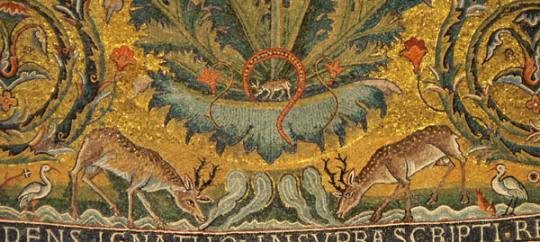

#hazbin hotel#hazbin analysis#vivziepop#lucifer#hazbin lucifer#lucifer hazbin hotel#lucifer headcanons#lucifer morningstar#hazbin hotel lucifer#lucifer magne#radio apple#radioapple#hazbin hotel alastor#alastor the radio demon#alastor#hazbin hotel analysis#religious imagery#radio demon#alastor and lucifer#hh commentary#hh analysis#character analysis#hazbin hotel vivziepop
414 notes
·
View notes
Text
Forger Fam and WISE Budget😅
Sylvia’s current concern according to Endo: Balancing WISE Budget

I mean how couldn’t she be concerned when maintaining Strix is so financially consuming.
I mean look at all the expenses the Forger family has made in less than a year:
1.Anya’s tuition that costs about $35,000 to $40,000, and that doesn’t include the uniform and school supplies.
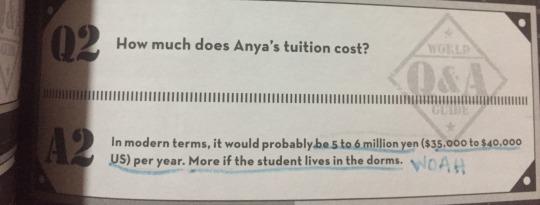
2.Anya’s clothes and she seemed to have new clothes regularly and Endo said these are mostly bought by Loid/Twilight.

3.That castle rent that costs more than $77 000 and added the other check, I'm guessing for the furniture they used, that costs $17 600. (Yes, it costs more than Anya's tuition fee, I mean it's a castle 😂)
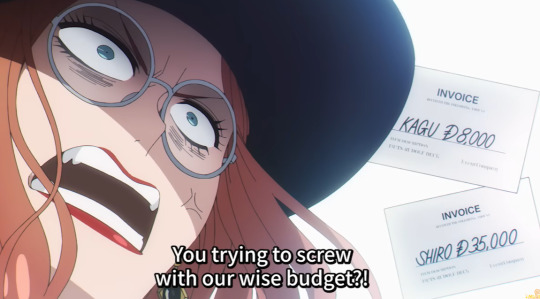
4.Loid could also not just be purchasing clothes for Anya. It looks like he also pays for Yor’s wardrobe and Yor mentioned that he got so many clothes for her in the boutique before the Eden Interview.
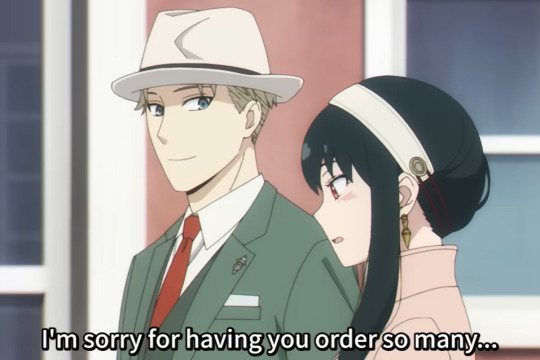
5.Loid is also the one who pays for their dates, seems like, and his dates with Yor doesn’t seem cheap at all, they seem to dine at fancy restaurants that require reservation.
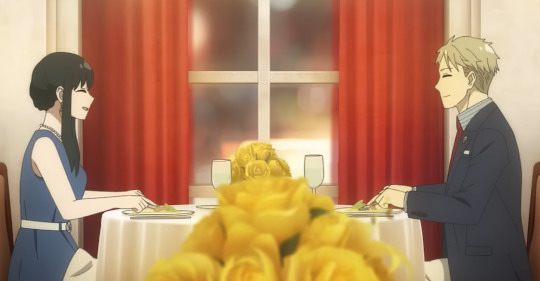
6.The big heap of cash he pays Franky every time he babysits Anya and Bond.
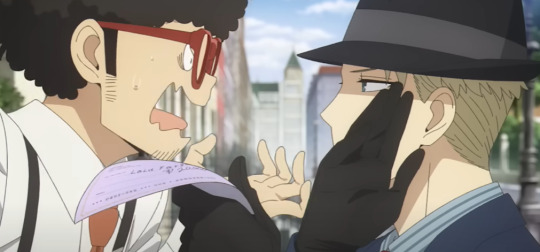
And here it looks like the check his giving Franky costs 20,000 dalcs that is equivalent to $44,000 (one dalc is quivalent to $2.20). It's even more expensive than Anya's tuition, what?! 😂😂 (Twilight is literally willing to spend a lot money just to be sure that Anya won't be home alone ever again, he's not taking a chance on her being kidnapped again when he left her alone on ep1)
7.Loid didn’t seem to also hold back in spending a good amount of money for their apartments furniture and for Anya’s bedroom and even bought her a lot of toys and picture books.

8.And of course their out of town/out of the country family trips featured in the Code White movie. Those must’ve cost a lot considering they have to book a hotel and all. And according to a movie spoiler from tiktok, that wasn’t the last time they went on a family out of town trip.

Loid Forger does have a high paying profession. However, according to Endo, his earnings as a psychiatrist were only about $140,000 per year, not per month, PER YEAR. How could he cover that much expenses? Of course WISE covers the rest if it was crucial to the mission, or when Twilight insists it to be. I mean he always says that everything he does is for his mission so the one who has to pay was the one who gave him that mission.
(Most of these expenses didn't even contribute to the progress of Operation Strix. It just funds Twilight into sinking deeper into his fake fam and keeps the family even more attached to each other😂)

Endo said WISE is not really generous when it comes to paying their agents but they seem to be lenient on spending their money on the Forgers. I mean they have to invest for their Top Spy's family and World Peace do depend on them.
So Twilight, pile the bills and let Sylvia handle the rest😂
#spy x family#spy x family manga#spy x family anime#sxf anime#sxf manga#loid forger#twilight#yor forger#anya forger#sxf analysis#spy x family analysis#forger family#the forgers#WISE got money to burn#Endo did say that that Westalis is richer than Ostania#Poor Sylvia#I wonder how is she auditing all these expenses to the higher ups#It's for the mission so it's fine#sxf commentary#spy x family commentary
592 notes
·
View notes
Text
Just saw a "feminist" video essay (by someone who just happens to only talk about feminism in relation to cishet white able bodied women) say that the Hays Code was good for women because it "prevented them from sexualizing women by preventing onscreen depictions of sex". Never before has a video said something that made me vocalize my disgust of it's takes, but this did it.
I didn't think I would have to say this but if you defend the Hays code you are horrible and not in any way progressive. And if you don't know what it is please look it up because it's probably the most important piece of history when it comes to all media analysis in the western world.
#196#my thougts#leftist#leftism#feminist#feminism#queer#media criticism#media literacy#media analysis#the internet#social commentary#discourse#proship#fuck antishippers#hays code#film history#cinema#white feminism
262 notes
·
View notes
Text
Why I love how the first movie dealt with Hiccstrid
Early on in the first movie, it becomes clear that Hiccup has feelings for Astrid, although he never directly says so. His actions and the way he looks at her speaks for itself.
Hiccup also says that he hopes that by hunting dragons, he might find himself a girlfriend, but he never specifies that it is Astrid he’s interested in.
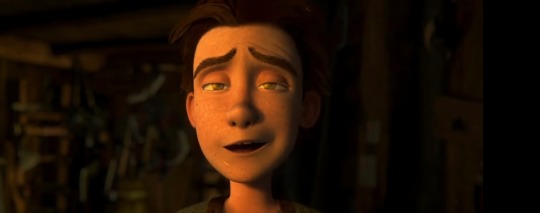
Still, Hiccup's crush on Astrid is not the main focus of the story, in fact, romance is brought up very little. While he attempts to impress her and the others during training and flirts with her once, he never becomes blinded by his feelings for her, not even after their romantic flight which leads to his feelings for her being requited.
He doesn’t do this

This
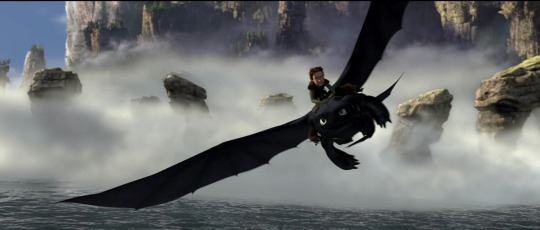
Or even this

To impress her.
Even though Hiccup initially had a crush on Astrid and later developed deep feelings for her, his motivation to become a hero was never driven by his feelings for her, and that’s not something you can say about all protagonist in movies.
#one too many times have I watched movies or shows where the hero only becomes the hero to get the girl#httyd#how to train your dragon#httyd 1#analysis#commentary#screen caps#Hiccstrid#hiccup#Astrid#toothless#red death#1k notes
1K notes
·
View notes
Text
The Watcher's telescope view is a social commentary and here's why
Ok so let's set some things right first.
City of Tears is amazing.

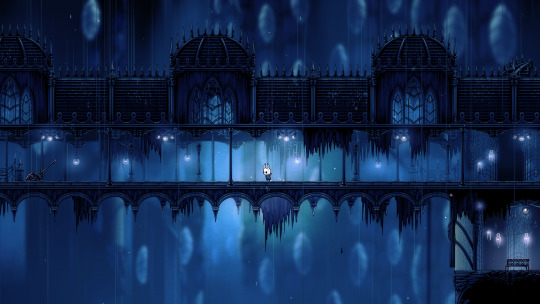


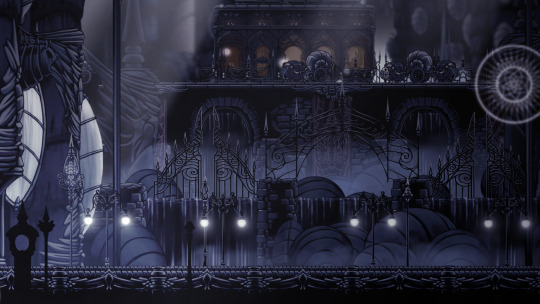

(Yes, Pale Court is also an amazing mod)
I've played Hollow Knight many times, and City of Tears is probably the one location I never get tired of. The scenery, the lore, the room layout, the music, the atmosphere - it's all perfect. It's the culmination of Halllownest's beauty, the peak of the game's art style, and the narrative's most essential location. City of Tears is the heart of Hollow Knight.
This game is a story about a Kingdom and its death, a tragedy of a society that was built on dreams of light but ultimately was consumed by the light so much that darkness became its only hope. And City of Tears stands at the center of this story. So it's fitting that the themes of corrupted dreams, society flaws, and dark hopes are what shape the lore and atmosphere of this beautiful, gorgeous location.
Did you ever notice that the tears of this Kingdom are dark despite them originating in a glowing blue lake, and the waters that flood the streets are almost as dark as the void in the Abyss? Do you ever think about how the vibrant blue color of the City is basically a culmination of how the color blue is presented in other locations (Howling Cliffs, Forgotten Crossroads, and later Royal Waterways being more of a remix of it), and how it's tied to the very essence of Hallownest (and how Resting Grounds, the location that contains Blue Lake and also uses a bright blue color, represent the very foundation of Hallownest's history, that being Seer's story about the Moth Tribe's betrayal that started the war between Pale King and the Radiance)? Do you feel like Soul Master basically represents the thunder and the lightning in this never-ending rain? Do you get it????
Anyway yeah, there are many things that can be said about City of Tears, and this is hopefully not the last time I make a post about it. What I want to talk about here is the City's society.
Basically, Monomon said it better than anyone could:
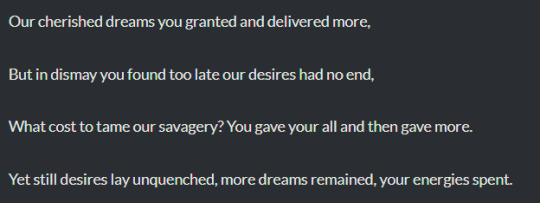
It's a very complicated topic. The narrative basically explores the inner mechanisms of a free mind, how its primary need is finding a purpose, and how its purpose turns out to be a constant need of... something. Anything. As long as there is something to want, a free mind will want it. As long as there is something to yearn for, something to enjoy, something to dream about, our minds are going to move in its direction, never wanting to stop. Because a stasis is worse than death. Because a world without dreams is an empty world.
But then again, isn't constant yearning another instance of, well, constance? If dreams never end but also never evolve, doesn't that create another kind of stasis?
Like I said, it's very complicated. Let's go back to what I was getting at in the first place. What I actually wanted to say is this:

Theese guys fucking fucked up as a society.
It's classic dystopian shit (or maybe I'm using the wrong word, but you get the point). Rich people are living in luxury while the rest are suffering. They're making gold a fucking religion and are seeing it as the only beauty in the world. The corrupt upper class are using heavy gatekeeping on the lower class.
Literally.
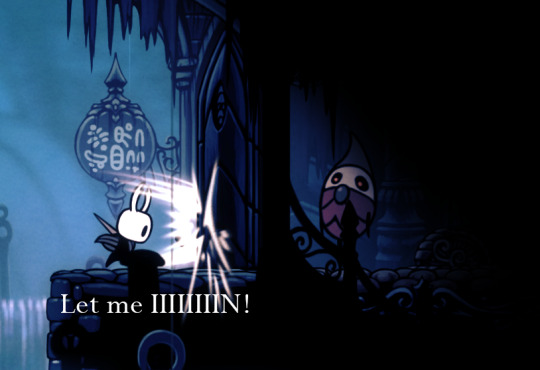
What's interesting is that, at first, we barely see any lower class bugs in the City. There's suspiciously few regular husks in this location, compared to how many rich guys are on the eastern side. But then we get to Soul Sanctum and it all starts to make sense.

There are no red cloaks in those corpse piles. Only the poor were killed for those experiments. It can't be a coincidence. It's straight-up elitism-based genocide (again, I don't know if I'm using the right terms, correct me if there's a better way to say that, but the point is clear).
Also, see how many streets are flooded on the western side in comparison to the eastern side.

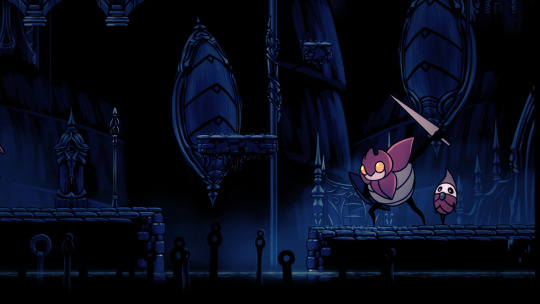
Point is, the bugs that ruined the kingdom by always wanting more (what Monomon wrote about) are most likely theese rich ones. It's a very fitting thing for this dystopian narrative: neverending greed that leads to the downfall of a civilization.
There's a note in the Hunter's Journal that describes it in the best way possible:

For every location in the game, there is a place that functions as the center of its essence, its narrative heart, the culmination of its themes. For Queen's Gardens it's the White Lady's cocoon, for Greenpath it's the Lake of Unn, and for City of Tears (or at least its eastern part, the one with the upper class) it's the Watcher's Spire. The tallest building of the great capital. The home of (evidently) the most rich and influential bug of the City's high society. Literally the top of this social hierarchy.
He is also arguably the most mysterious dreamer out of all three. I mean, why does he have only one eye? What type of bug is he? How did he get this much power? Does he really have some kind of connection with the Collector? Is he a motherfucking fluke? Why does he seem to have an obsession with serving the King?
That last question is kinda answered by the cut content though.

That last sentence is kinda confusing. Is it regret? Is it humility? Is it pride in his sacrifice? In any case, here we see that Lurien actually knew that the Pale King was literally a god, and desired to worship him, like any other bug yearns to worship some kind of deity. So while other bugs of Hallownest worshiped PK because he was a monarch, albeit a godlike one (for all they knew he could be just an extraordinary bug, but a bug nonetheless), Lurien worshiped him as an actual god. And the intricacies of worshiping a god are one of the central themes of the game. From the moth tribe's betrayal of Radiance leading to the birth of the Infection to the Godseeker's shenanigans leading to the birth of the Shade Lord - the game makes multiple statements about gods, religious devotion and the semantics of divine power. Just that one idea that a god takes its power from the ones that worship it deserves its own post - heck, it deserves its own book.
So yeah, Lurien's devotion to the King is an important part of the story. He sure is an important character in this narrative. He also got a cool house. Being able to observe the entirety of the Hallownest's capital is badass.
But there's one thing I find odd about all that, and it's the moment we get to actually look through his legendary telescope.

Is it just me, or does this feel kinda... Underwhelming? Almost disappointing? I mean, don't get me wrong, I love this view, it's beautiful, and I would certainly love to be able to see something like this with my own eyes irl, but, looking at this picture, I can't help but wonder...
Did he actually see anything from up there?
In cut dialogue, Lurien talks about how he loves the City's streets, and his hidden lore tablet contains words about his love for bugkind, but... I see neither any streets on this image, nor any bugs (that are not vengeflies). Only spiked rooftops and rainy fog, clouding the view of the actual City.
And sure, the Spire has many windows and even had multiple watchers who were helping Lurien with overseeing the capital...
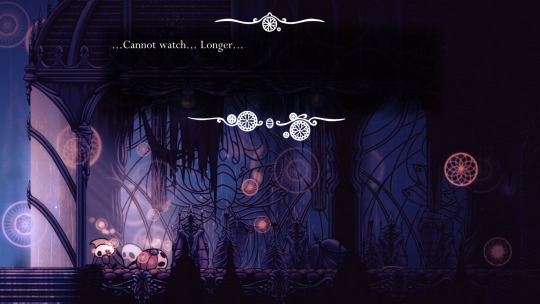
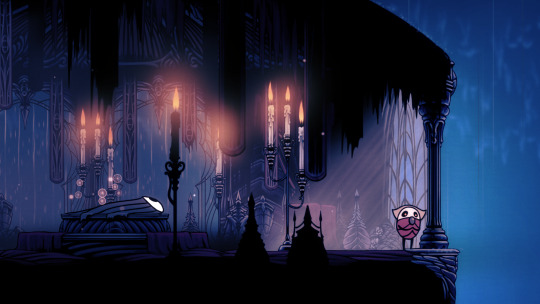
But his own spot was always this one.
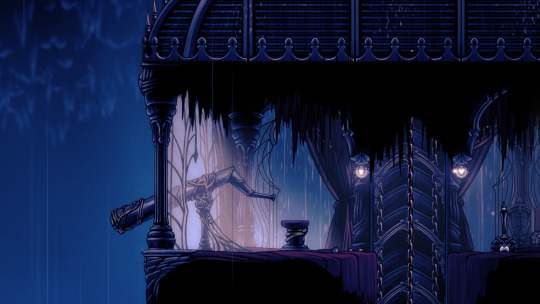
His telescope was sealed in one place, letting him see only a small portion of the City and its life. Almost like his own worldview was stuck in one perspective.
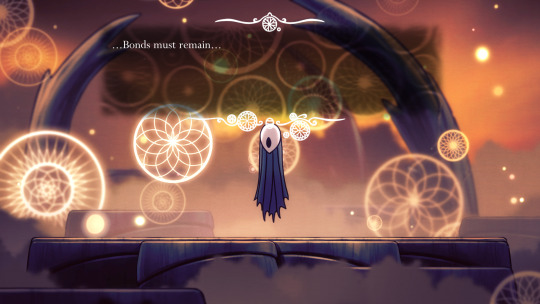
Notice the wording here. It's not "The Seals must remain". It's "Bonds must remain". He's not thinking just about the Seals containing the Infection. He's thinking about the whole Kingdom needing to stay unchanged. His dream is the stasis that the Knight (and also Monomon, Hornet and, in a sense, even Radiance) want to end. The stasis that the Pale King wanted to create in order for his Kingdom (and therefore himself) to be eternal. The stasis that would allow for both Pale King and Lurien's worship of him to remain forever.
But there is always a cost to ascending higher than others, and it's that you can no longer see what's going on below or who's suffering down there. I think Lurien, sitting atop the tallest tower, was actually detached from the struggles of regular bugs. He and his Spire are the culmination of the City's upper class' ignorance towards the ones who were below them on the social hierarchy. A dreamer who dreamt of watching over the very heart of the holy civilization lived so high up he could no longer see his beloved world in its complicated, detailed entirety – and the tears of the stasis created by those like him only blinded him more.
All those flooded streets, those broken buildings, those empty halls, those starving bugs, those sealed doors - even though he watched over them, he couldn't see them.
I'm pretty sure Lurien didn't even know about the Soul Master's experiments, despite the fact that the Soul Sanctum was located right next to his Spire.
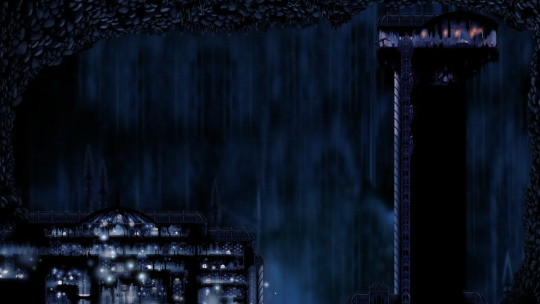
Or maybe he knew but chose to turn a blind eye to it (pun intended).
But it's kind of poetic, isn't it? It's the beauty of the tragedy of this game's characters. A Beast who had to surrender everything to the opposing civilization. A Teacher who could no longer teach. A Watcher who couldn't see the truth.
And all that makes me wonder... How much suffering could the Pale King see, standing on that platform at the top of the Abyss, facing away from the pit where his children died?
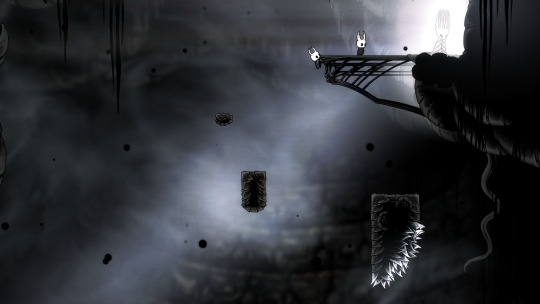
TL;DR: Lurien's point of view was too high up to actually see what was truly going on down there, both literally and metaphorically. His desire to worship the Pale King made him ignorant of the struggles of regular bugs. Similarly, the extreme elitism of the high society of Hallownest lead to ignorance, discrimination and greed, which ultimately caused the sprawl of the Infection. This side of Lurien's story might also parallel the Pale King's with his ignorance towards the discarded vessels.
TL;DR²: Eat the rich
#hollow knight#hollow knight theory#hollow knight lore#lurien the watcher#city of tears#hallownest#pale king#monomon the teacher#soul master#character analysis#social commentary
225 notes
·
View notes
Text
Alright, even though I haven't yet read a full translation of "Bad Boy, I just want to talk about some things from the pages we do have translated and what we see happen in the story itself.
I don't t think the level of psychological trauma Levi's experiences in this story can be overstated.
We see Levi cry when his mother's cup breaks on the floor. I think what's important to note about this, is that it takes place directly following Levi violently and brutally killing a group of men who had been threatening and beating him.
The first man Levi kills very nearly beats Levi to death. He's using a hammer fist to beat him, meaning his balled fist, and using the edge of his fist, not his knuckles, to beat Levi over and over, with Levi's head against the stone ground. He would have eventually beaten Levi to death if Levi's power hadn't awoken when it did. We also realize that Kenny has abandoned Levi before this happens. Looking through the panels again, I noticed Levi is wearing different clothes when Kenny leaves him than what he's wearing here, in the present. That means Kenny left Levi before his powers even awakened. He left him to fend for himself, a 9 year old child, on the streets of a place that had men like these prowling around, waiting and looking to prey on children, men who felt no hesitation in beating a child to death, or selling that child into sexual slavery. Clearly, Kenny couldn't be bothered to even wait for Levi to develop his actual powers before throwing him to the wolves. And once Kenny walks away, after years of drilling into him that strength is the only thing that matters, Levi is left not understanding what any of it was even for. His power finally awakens, and he brutally kills these men, and he doesn't understand any of it. He was taught violence, but for what purpose? He even asks "What's it for?" to the sole remaining assailant. He's talking about his strength. He doesn't understand why he's so strong, when it's gained him seemingly nothing, and resulted in nothing good. He's still alone, he's still in the dark, he's still existing in a world and in a life that offers him nothing but despair and hopelessness.
And this last man, in my view, is truly the most vile of the group. A truly cruel and hateful coward. We see this man begin to try and manipulate Levi, threatening him and lying to him about his own intentions, trying to claim he meant to "save" Levi, and perhaps most disgusting of all, using Levi's love for his mother against him in some twisted attempt to save his own life, by telling Levi that he would be sullying the memory of her by killing him. I can't begin to imagine the psychological toll this man's words had on Levi following this entire experience. I don't know what the entirety of the dialog between them is, yet, and I'll give a better analysis once that's revealed. But I think it's safe to assume, given what happens with Levi after, that this man's words to Levi likely solidified in Levi himself a belief in his own monstrosity.
Because we see Levi crying, after. When his mother's cup breaks in his hand, and shatters against the floor.
This is a trauma response.
Levi was clearly in shock leading up to that moment. We see him return to the place he and his mother presumably once lived, and we see Levi prepare a cup of tea, afterward staring vacantly into the liquid of the cup, remembering a clearly romanticized image of he and his mother drinking tea in that same spot. I say it's clearly romanticized, because we see a shaft of light in Levi's memory, coming down on the two of them, when in reality, in the present, there is no light at all. It's complete darkness. It's complete despair. I don't think Levi remembers his mother well. He clearly only has an impression of her, and it's an impression he's clearly idealized. An image of elegance and beauty in a world of filth and ruin.
When he picks the cups up to drink from it, the handle snaps, and the cup falls, shattering on the floor. The cup breaking is what finally snaps Levi out of his shock, and finally all the emotion of what's just happened to him comes crashing down, and he begins to cry. Again, this is very obviously a trauma response. It's not the cup itself breaking, but what it represents, I think, that reduces Levi to tears.
Because, really, that cup shattering represents the shattering of Levi's own innocence.
We can assume this is the first time he kills, and we see the devastating effect of it on Levi in the aftermath.
He's alone, abandoned by Kenny without explanation, after Kenny's approval of him had seemed predicated on Levi becoming strong. And so Levi is left here with nothing but confusion, the fading memory of his mother, the blood on his hands, something forced on him both by Kenny and the men who were attacking him, and with that horrible man's words no doubt echoing in his ears about how killing him would sully his mother's memory, that idealized image he has of his mother. One has to think Levi's own self-image was warped into that of a monster.
Levi killed those men with his bare hands, and in doing so, he displayed a truly shocking amount of strength. I'm talking something equivalent to or even greater than a brown bear or a tiger. We have to remember here that Levi is only 9 years old. He's a child. And he's able to do this.
And yet, it didn't come naturally to him at all.
Levi wanted these men to give back his mothers tea set. He asked them to give it back to him, because it didn't belong to them. He still asks, even after they beat him badly.
It's only after the brutality of their attack increases, that we see Levi try to actually fight back. He lands a punch on the man holding him down, and then that man begins to beat Levi to within an inch of his life, bringing his fist down on him over and over again, until Levi's power awakens and explodes out of him.
Levi resorted to violence in response to their increasing violence against him, but it wasn't his initial response. I know I go on and on about how I don't believe Levi is naturally inclined toward violence at all, but I think this story, for all its intense violence, demonstrates that beyond doubt.
Because Levi finally loses it, and he kills these men, and he does it in truly terrifying fashion. He tears them apart the way an animal would tear a person apart. He shows no mercy to the final man, who tries to squirm his way out of paying for his actions by lying to Levi and guilt-tripping him. It doesn't work, though. Levi kills him, too, and he does all this with seemingly no remorse and no feeling.
But, again, I come back to the immediate aftermath, when Kuchel's cup shatters on the floor, and we're reminded in stark, naked fashion that Levi is just a child. He was an innocent child. And that innocence was stolen from him by this incident. By Kenny teaching him how to kill, teaching him that strength was the only thing that mattered, but not explaining to him why before leaving him. By these men nearly killing him, by their brutality and cruelty and ugliness. By Levi having to kill them to save himself. And by his grieving fury and confusion over the point of any of it, when he kills the final man, even when he didn't have to. Levi breaking down into tears has nothing to do with the cup itself, but with what's just happened. He's horrified. I think he's horrified with himself, and he's alone, and the last, good memory he has, the one point of light in his life, this single, vague memory of his mother, has been shattered to pieces, literally and figuratively, with the shattering of Levi's own innocence.
I think that point of contrast, his memory of his mother's elegance and grace, with the brutality and violence of himself, in that moment, devastates Levi. I think he feels ashamed. I think he believes in that horrible man's words to him, about how he's disgraced his mother's memory by doing what he's done. Can there be any doubt that Levi begins to think of himself from this point on as an animal? As a monster? As "abnormal"?
We know from "No Regrets" and Isayama's own words, that Levi didn't have any friends until he met Furlan and Isabel, two people he didn't know until he himself was full grown. And so we know that from the age of 9, or even younger, since we see Kenny leave Levi before his powers even awaken, he's been on his own. He's been on his own all this time, while harboring the belief that he's some sort of savage and violent killer. That he's some kind of monster, possessing an immense strength that seems meant for nothing but death and destruction. As though he were an engine for pointless death and destruction.
And yet, all on his own, he comes to realize that his strength can be used for something else. That it can be used to help people. He saves Furlan's life, and he saves Isabel's life. And from that point on, with this realization of what his strength can be used for, Levi dedicates himself to that end. To using this immense and frightening strength to help people.
That Levi could come out of this experience still with the ability to love, to still have in him the ability to be loved, despite how all he'd ever known from love was suffering, and that he could come out of this still with the deep desire to help others, to do good, is honestly nothing short of a miracle, and I think it demonstrates more powerfully than anything the innate goodness in Levi.
Because there's so much negativity wrapped up in the concept of love for Levi. He watched his mother die, succumbing to disease, and there's little doubt in my mind that Levi blamed himself for that, her ability to care for herself compromised by his presence in her life, by being another mouth to feed, another back to clothe, when she could scarce afford to feed herself, could scarce afford to put clothes on her own back. And for his own love for her to end in an eruption of blood and violence, and the loss of his innocence, for Levi to come out of that with the ability to still connect with people, to form connections, to love and care for them, and allow himself to be loved and cared for in turn, it can only come from a deep well of genuine and innate goodness. From a heart that longs for kindness and compassion, even in the face of utter cruelty and despair.
Levi's tears demonstrate his despair and grief at his own violence. They demonstrate his bereavement and regret. They demonstrate his horror and loneliness. And they demonstrate, at his core, the persistence of a pure and loving heart that wishes to do and be good.
All of this horror wasn't enough to stamp out the goodness in Levi.
Despite it all, he became a genuine hero.
Despite it all, the goodness in him remains.
196 notes
·
View notes
Text
THE DICE IN EPISODE NINE WERE MENTIONED IN EPISODE FOUR.
“The stranger reached over and retrieved from behind the log on which he sat an unusually shaped sack. Within it, I could spy an assortment of trinkets, ranging from battered knives and chipped porcelain to fine jewelry, small ivory figures and even a set of gambler’s dice.”
DUDE.
Thank you to my dear friend who suggested we check!
298 notes
·
View notes
Text
The context that Bernard knows Tim's Robin means this sentence can be read two ways.
"My boyfriend, named Tim Drake."
"My boyfriend, you."
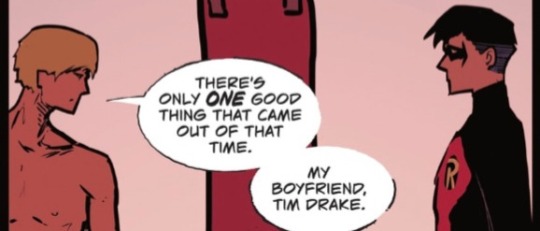
#dc#dc comics#comics#comic books#comic panels#tim drake robin#comic analysis#media analysis#media commentary#tim drake#robin#red robin#bernard dowd#character dialogue#ships#hero x civilian#ship dynamics#timber#timbern#tim x bernard#angst#lgbtq+#canon queer characters#mlm characters#bi characters#dc pride tim drake special#batman urban legends
1K notes
·
View notes
Text
So I already pointed out that the Aerith "No Promises to Keep" song was emulating The Greatest Showman for the performance and high affection!Clerith aspect (likely because Loren Allred sings both)—



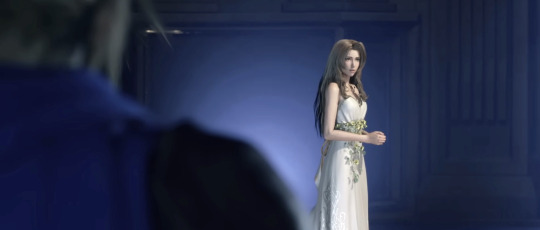
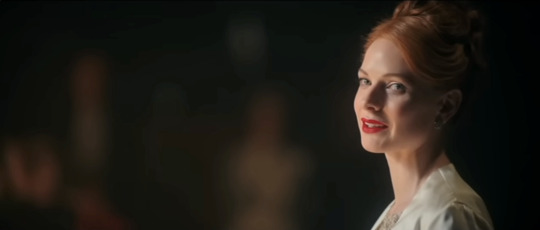

but what I didn't realize until I watched the TGS scene is that they pulled both romance options from it...only the high affection!Cloti scene handhold was inspired by Zac Efron & Zendaya's characters.







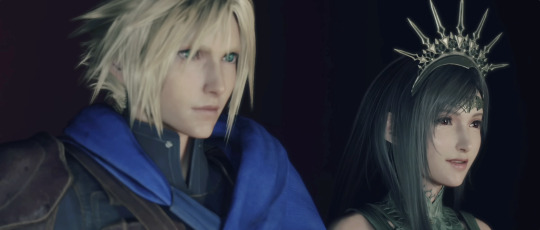
...honestly I'm not surprised, just amused they used so much from one place. This feels like finding all the parallels to Game of Thrones shots in FFXVI lmaooo
#there is no ship commentary going on here! I just love that you can CLEARLY see where inspo was drawn with games same as TV/film#also imagine thinking I spent 2 years doing parallel analysis for stranger things & it would stop when I moved to other fandoms on main LOL#clerith#cloti#cloud strife#tifa lockhart#aerith gainsborough#ffvii#ffvii analysis#ffvii spoilers#final fantasy#the me tag
164 notes
·
View notes
Text
Something I really appreciate in The Artful Dodger is the lack of focus on Belle’s clothing in the series. Not in the sense that the production didn’t focus on it they did a fantastic job with her costuming and I love it and am obsessed with all of her looks.
I just feel like in period dramas there’s usually at least one conversation about women’s clothing (that never happens about men’s clothing). The tone of it varies sometimes it’s the standard girlboss thing of “corsets are so stupid I can’t stand them” and sometimes it’s the opposite and defending the fashions, but either way there’s always this attention called to fashion surrounding female characters.
But in The Artful Dodger Belle’s outfits are simply outfits. There’s a couple instances obviously where like Jack tells her she’ll want to change clothes. But Belle never mentions her clothes when talking about her struggles as a woman. She never makes snide remarks about Fanny’s more frilly outfits. She doesn’t bemoan the impracticality of her skirts or corset and neither does anyone else.
We get vibes and characterization from the different aesthetics of characters clothing. The costuming is very intentional and well done and the work put into them matters deeply for the overall quality and effect of the show. However, Belle’s outfits and the female characters outfits in general are no more made a part of their personality than they are for the male characters. They’re treated equally for both the male and female characters as an extension of them and the setting and overall aesthetic of the show.
And to be clear I’m not criticizing discussion of women’s fashion in period dramas there’s a time and place for it and lots of interesting conversations to be had around it. But I just like that in this show they chose not to take that route and instead focused on other things. It’s really refreshing.
#I’m rambling apologies if that didn’t make sense lmao#this is just my opinion obviously#commentary#the artful dodger#the artful dodger disney plus#the artful dodger hulu#artful dodger#lady belle analysis#lady belle fox#lady belle#belle fox#my post
248 notes
·
View notes
Text
So, I haven't slept all night and now I have a migraine so I took some Excedrin which has caffeine meaning I am W I R E D and have nothing better to do than spend an hour + make this timeline of Hazbin Hotel mostly by memory:
I have it separated based on events of Sinners vs events mainly impacting angels because it was getting too clogged anyways and I reformatted it too many times to go again.
(This is based on information revealed in the show as well as in livestreams, so it’s possible the livestream data may be outdated, for now I’m gonna keep it in because it gives us a better timeline. Also, I’m assuming that the events of the show begin in 2019.)

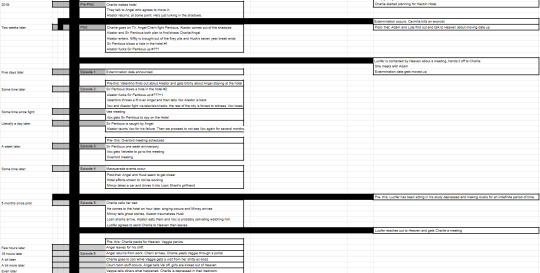

Below I'll post the text of what's basically listed in the table:
10,000+ years ago:
-Heaven existed
-Lucifer existed
-Heaven made Adam and Lilith
-Lucifer met Lilith
-Tempted Eve with the apple
-Evil was brought into the world, Lilith and Lucifer expelled to Hell
1500-1700s (presumably, based on way of speaking): Zestial lived and died
200 years ago (1800s): Charlie was born
Early-mid 1800s: Sir Pentious was born
1800s-1910s: Rosie died
1888: Sir Pentious died
Post 1888: Egg Boiz made (assuming Pentious didn’t somehow just find them)
1890-1900s: Alastor was born
1900-1910s: Husk was born
1910s: Angel was born
1910-1920s: Vox was born
1920s: Mimzy died
1928-1937: Niffty born
1933: Alastor died (aged 30-40s)
Post- 1933: Alastor killed overlords and claimed power. Sir Pentious battled him numerous times over the years but wasn’t very memorable.
1947: Angel died (aged 30s)
1950s: Niffty died (age 22)
Post- 1950s: Niffty met Alastor and sold her soul (?) to him
1950s: Vox died (aged 30-40s)
Post- 1950s: Vox met Alastor and two worked together for a bit
1960s: Cherri was born
1970s: Husk died (aged 60-70s)
Post- 1970s: Husk gained power as an overlord before later losing it and selling his soul to Alastor
1970s: Valentino died (age unknown)
Post- 1970s: Valentino gained power as an overlord and Angel sold his soul to him
1980s: Cherri died (aged 20s)
Post 1980s: Angel and Cherri met. Cherri and Sir Pentious began rivalry at some point.
2012 (assuming show takes place in 2019): Charlie’s mother left. Vox asks Alastor to join his team. Alastor leaves. Husk gets his seven year break from Alastor.
Post 2012s: Lilith goes to Heaven and makes some kind of deal involving Lute
Before 2016: Vaggie work as an exorcist
2016 or before: Vaggie meets Charlie
2019:
Two weeks before pilot: Angel accepts offer to live at hotel, leaves Valentino
Pre-pilot: Alastor returns. He’s kind of just lurking for whoever long.
Pilot:
-Extermination occurs, Carmilla kills an angel
-Post- extermination: Adam and Lute find out about the dead exorcist
-Charlie goes on TV and it goes badly. Angel and Cherri fight Sir Pentious. Alastor comes out of the shadows to cause drama.
-Niffty is brought from the firey pits and Husk’s seven year break is over
-Sir Pentious blows a hole in the hotel #1
-Alastor fucks Pentious up #???
Five days later, episode 1:
-Lucifer gets contacted by Heaven asking to meet
-Lucifer hands this off to Charlie, bad meeting occurs. Six months taken off schedule.
Pre-episode 2: Valentino finds out Alastor is back.
Some time later, episode 2:
-Sir Pentious blows a hole in the hotel #2
-Alastor fucks Pentious #??? +1
-Valentino throws a fit about Angel leaving
-Valentino tells Vox Alastor is back, Vox proceeds to throw a fit on live television
-They contract Sir Pentious to spy on hotel
-Sir Pentious attempts to, that night he is caught
-Alastor taunts Vox and then we as the audience proceed to not hear from Vox for several months
Pre-episode 3: Overlord meeting scheduled
One week later, episode 3:
-Sir Pentious one week anniversary
-Vox gets Velvette to go to the Overlord meeting
-Overlord meeting
Some time later, episode 4:
-Masquerade occurs, all in one day
-Pre-episode 5: Husk and Angel seem to get closer to a point that they share popcorn and Husk serves Angel drinks without asking.
-Pre-episode 5: The entire hotel gets closer
-Pre episode 5: Hotel efforts not working
-Pre episode 5: Mimzy takes a car and runs over a loan shark’s girlfriend
Some time later, a month before the next extermination (4 months or so since pilot):
-Charlie panics and finally calls dad
-Lucifer comes an hour later, singing ensues, Mimzy arrives
-Loan sharks arrives, Alastor fucks them up (while Vox is probably salivating while watching it all on camera)
-Lucifer agrees to get Charlie her meeting with Heaven, leaves
-A month before extermination 2: Angel has to go to work a 16 hour shift. Texts Cherri during it.
-16 hours later: Angel returns. Cherri arrives. Vaggie and Charlie go to Heaven.
-Hours later: the courtroom shit happens, Angel tells Val off
-The girls are kicked out of Heaven
-A bit later: Charlie goes to her room and Vaggie explains what happened
-Charlie makes deal with Alastor
-Vaggie tells rest of crew they can leave
-Vaggie and Charlie rally forces. Crew decided not to leave.
Later that week (presumably): Angel “pays for it” at work with Val
Over course of a month: Angelic weapons made, Cherri agreed to fight, cannibals prepare, everyone prepares for war, Vox sits back and laughs
Day before extermination 2: Final rallying of troops, celebrate last night.
Pre-Extermination 2: Vox convinces Velvette and Val to watch the footage with him on a TV
Extermination 2:
-Alastor gets pwned and fucks off
-Sir Pentious blips out of existence
-Post- that: Sir Pentious arrives in heaven
-Dazzle is killed, Lute and Vaggie fight
-Charlie and Adam fight
-Some point before this: Lucifer is alerted to what is happening
-Lucifer swoops in
-Niffty stabs Adam
-They decide to rebuild hotel
Post all that: Lute tells Lilith that Adam is dead
Some time later:
-Rebuild hotel, Husk gets another break from Alastor
-Vees sing about how evil they are
-Alastor is angy
-Hotel is rebuilt and Alastor comes back and Husk’s break is again cut short
#hazbin hotel#hazbin hotel timeline#stupid hazbin hotel lists#in that I start inserting my commentary after a while because again I am sleep deprived#angel dust#angel dust hazbin hotel#charlie morningstar#lucifer hazbin hotel#lilith hazbin hotel#adam hazbin hotel#lute hazbin hotel#alastor hazbin hotel#husk hazbin hotel#husker hazbin hotel#niffty hazbin hotel#zestial#rosie hazbin hotel#sir pentious#Cherri bomb#vox hazbin hotel#valentino hazbin hotel#velvette hazbin hotel#the vees#chaggie#radiostatic#onewaybroadcast#hazbin hotel crack#hazbin hotel analysis
129 notes
·
View notes
Text
So y'all know how Jeff Combs was doing a theater production which someone involved with Re-Animator saw him in, and how he's suggested that the character he played there influenced how he played Herbert West.
I relayed this to @andalusiapunk and they were like "Oh! That explains it! He's theater-acting!"
I am not an expert by any means, but I did misspend my teenage years in a magnet school as a theater student. I understood immediately what they meant by theater-acting and I'm mad I didn't come up with it.
A lot of this has to do with Herbert's overall physicality. We all love talking about how he's hyper-dramatic, right? How he moves in a particular way that is extremely precise and sharp and, to be on point, theatrical. How he spins the tape recorder in his hand; how he offers Meg's heart in BRIDE; how he fumbles or manipulates syringes in various scenes.
None of that's in the script and it's not necessarily justified by what's happening... unless you're trying to make sure the audience in the backass end of the theater can see you're holding something small, like a tape recorder or a syringe or a human heart. As I observed elsewhere, you can trick the audience into 'seeing' or 'hearing' things that aren't present onstage or screen if your body language insists on its reality.
And, not to get into super-nerdy film history, but: originally theater-acting and movie-acting were one and the same. Early films are blocked like plays, they have extended sequences without constant cutting between shots (like an audience watching a play), and the extremely clear, over-enunciation of a play-actor trying to make sure those poor bastards in the back can hear what they're saying. And like a play, all acting was heavily rehearsed and expected to hit the same points and produce the same results every time.
What changed this was Marlon Brando introducing the idea of improvisation into movie-acting, a choice which also led to a greater flexibility in movie-acting... including delivery of lines. A more "natural", verisimilitudinous delivery became acceptable for films. This doesn't make either style bad, to be clear: each serves its purpose.
Bruce Abbott (to name the most obvious example) is doing movie-acting. He's got some Protagonist Accent going for him, but he has a clear variety of tone and a great deal of subtlety with his facial expressions and delivery. The same goes for the rest of the cast, although David Gale kind of straddles the line between these two styles.
Herbert's delivery is pure theater-acting. When he and Dan invade the morgue, Dan is whispering--but Herbert is stage whispering, which is why he hisses so much. I've made jokes on here before about how Herbert was born on Skid Row in Little Shop of Horrors-verse, and he thinks he's supposed to be in a musical... and, you know, LSOH is a film based on a play, only in that movie, EVERYBODY is theater-acting.
Anyhow, lotta words to find a different way to compliment Combs and the rest of the REANI cast on their acting, because I live for sorcery enjoying these damn movies.
#reanimator#re animator 1985#bride of re animator#bride of reanimator 1991#jeff combs#bruce abbott#david gale#acting#meta#uninformed commentary#i live for analysis#nothingenough speaks
88 notes
·
View notes